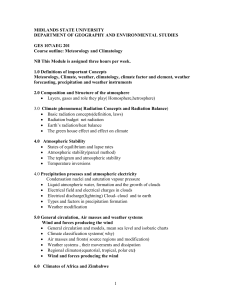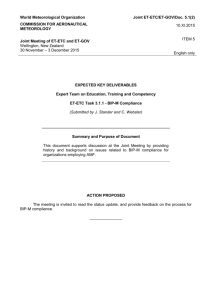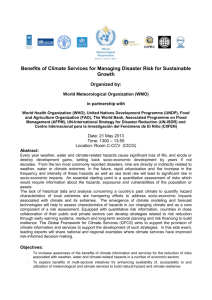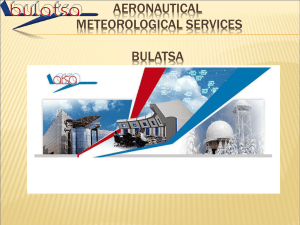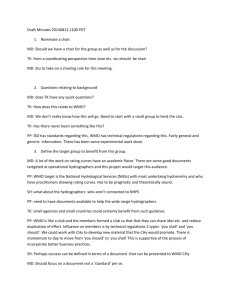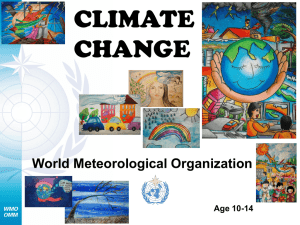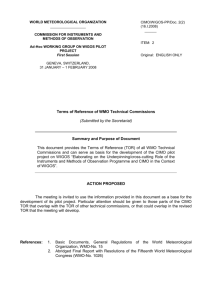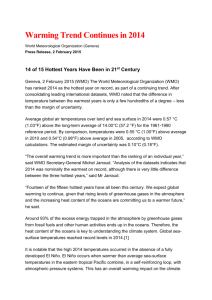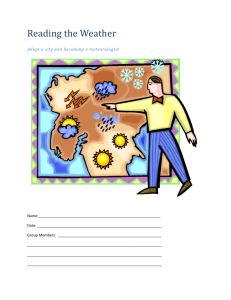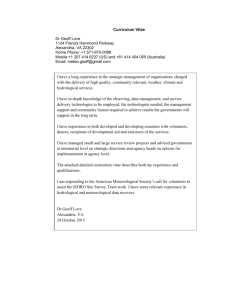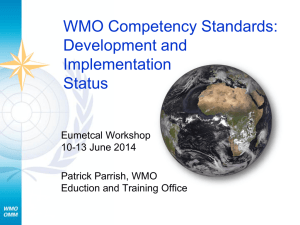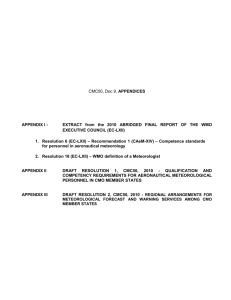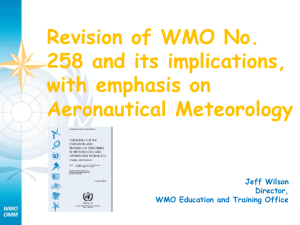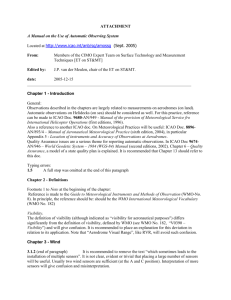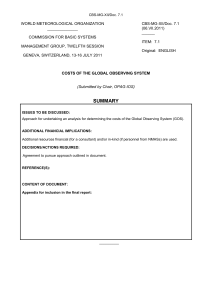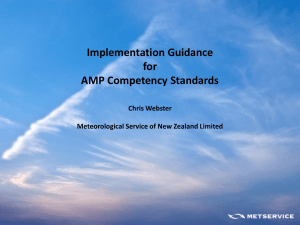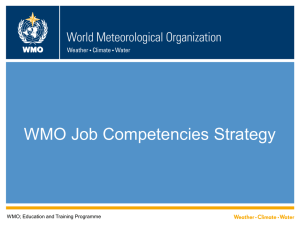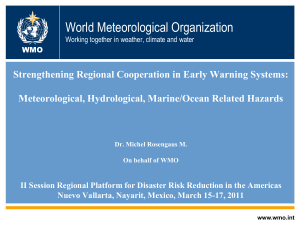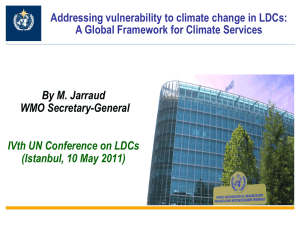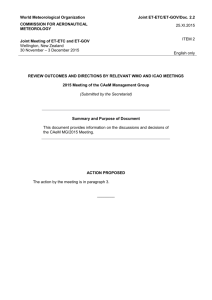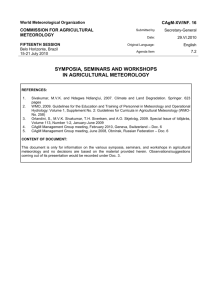Revision of WMO No. 258 and its implications, with emphasis on
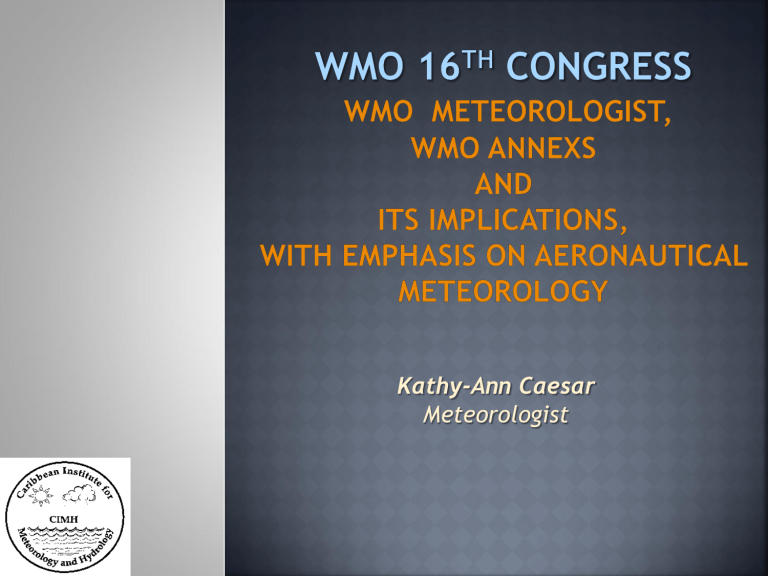
Kathy-Ann Caesar
Meteorologist
ICAO-Annex 3 ( standard ) WMO No 49
( standard ) WMO 258 ( guideline )
Is WMO – 258 - a guideline or a standard ?
Should there be a link between WMO classifications and specific jobs?
New definitions of Meteorological Personnel
Approved New WMO Technical Regulations No.
49.
Approved the replacement documents to WMO
Publication No. 258 4th edition the Guidelines to
Education document.
Approved the Aeronautical Meteorology
Programme that links job tasks to qualifications rather than classifications
Congress strongly supported the introduction of a competency-based system for personnel in aeronautical meteorology
Congress confirmed the amendment of the definition of Meteorologist and Meteorological
Technician :
“Meteorologist –
a person who has successfully completed the Basic
Instruction Package for Meteorologists (BIP-M) requirements at university degree-level ”, and
“Meteorological Technician –
a person who has successfully completed the Basic
Instruction Package for Meteorological Technicians
(BIP-MT) requirements ”.
The implementation date for the changed definitions and Basic Instruction Packages will be
1 December 2013 ;
Cg-XVI/B/WP 6.2 – Appendix C.
Draft Resolution 6.2/2 (Cg-XVI) – Definition of Meteorologist and
Meteorological Technician
December 2013 coincides with the requirement for meteorological service providers to ensure that their personnel meet the aeronautical meteorological personnel competencies.
NMS personnel have to show that they have successfully completed the BIP-M.
No grandfathering clause. Qualified meteorologist under the current definition will not have to do anything extra
However they are expected to have continued their professional development and
Those in aviation are expected to have documented this professional development.
WMO recognizes:
Regional education and training institutions
( RMTCs ), provide a programme of study that covers all of the BIP-M requirements, but does not lead to a formal qualification such as a degree etc*.
Such Institutions are expected to demonstrate that their programme attains the required WMO level, especially in terms of its breadth and depth of the
BIP-M;
Such a graduate will be deemed to have attained the level of a WMO meteorologist
In the case of aeronautical meteorology, the graduate is an Aeronautical Meteorological
Forecaster ( AMF )
Annex II – Guidelines to the implementations on the education and training standards in
Meteorology and Hydrology Vol-I Meteorology
Specifies the Basic Instruction Package for
Meteorologists (BIP-M) in terms of learning outcomes
Physical meteorology , including air quality and observing technology;
Dynamic meteorology , including Numerical Weather
Prediction (NWP);
Synoptic meteorology , including mesoscale meteorology and weather prediction;
Climatology , including both the traditional statistical description and the modern dynamical study and interpretation of the climate, as well as climate prediction;
A person who has successfully completed the BIP-M programme of study are able to:
Demonstrate systematic understanding of their field of study;
Accurately deploy established techniques of analysis and enquiry used in their field of study, and apply the learnt methods and techniques to review, consolidate, extend and apply their knowledge and understanding;
Use conceptual understanding that allows arguments to be devised and sustained and apply the understanding to the solving of problems in their field of study;
Critically evaluate arguments, assumptions, abstract concepts and data whilst taking into account the uncertainty, ambiguity and limits of knowledge of their field of study;
Communicate information , ideas, problems and solutions about their field of study to both specialist and non-specialist audiences.
Successful completion of the BIP-M …. does not mean that an individual is immediately able to competently perform a subsequent job;
Qualifications fall into two broad categories
:
Academic qualifications – ..awarded by a college or university.
…..specified in terms of a set of learning outcomes that have to be satisfied.
Vocational (professional) qualifications – …..awarded by a training institution or professional body. …..specified in terms of a set of competencies that have to be demonstrated
A Job will now have an associated set of competence standards defined by the required specialized knowledge, skills and behaviours .
Acquiring these competencies will require job-specific education and training that goes beyond the BIP-M and BIP-MT requirements
.
Top-level Competencies
Annex I [WMO 49 Vol 1] Standards
Second-level Competencies
Describe and elaborate on the standards
National Competencies
Use examples of the second level to adapt the top-level competencies to suit the national situation
Simplified
Previous requirement
AMF meet competency standards by 2013
AMF = WMO Meteorologist by 2016
WMO Meteorologist = BIP-M plus university degree or equivalent
Today
AMF meet competency standards by 2013
AMF = BIP-M
WMO Meteorologist = BIP-M
Questions …Comments
